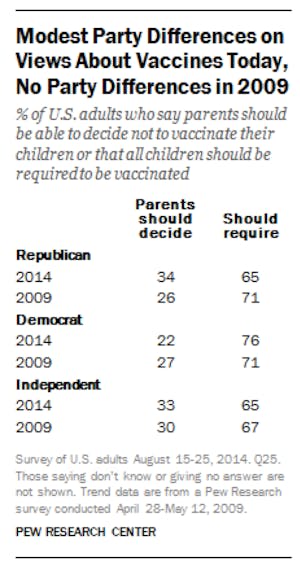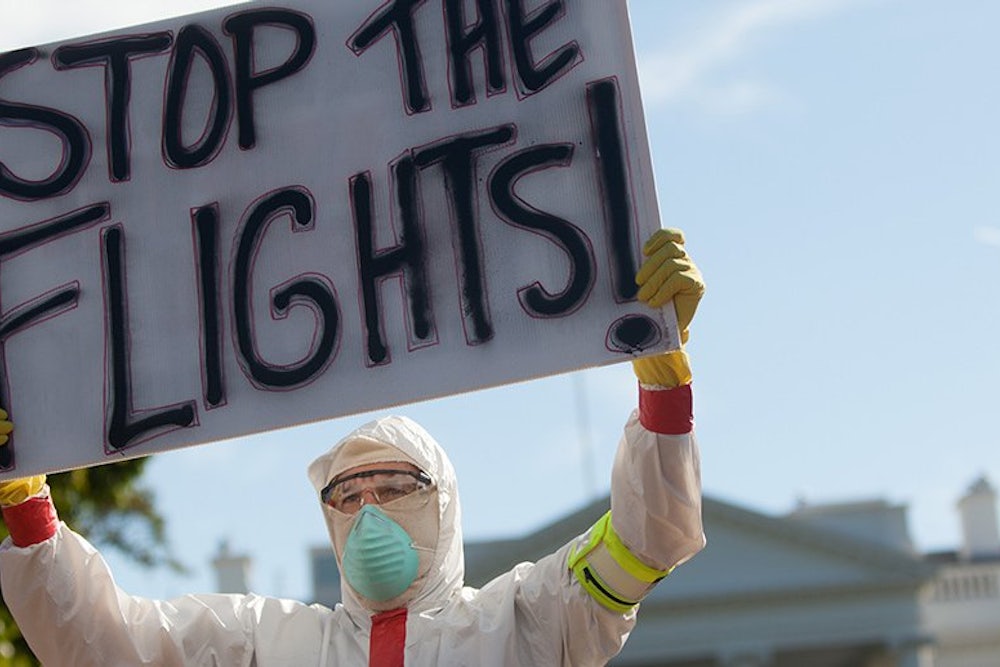With New Jersey Governor Chris Christie and Senator Rand Paul courting the anti-vaccine vote, while President Barack Obama and Hillary Clinton renounce it, both sides of the partisan divide seem eager to claim their moral high ground in the wake of the Disneyland measles outbreak. There's even a debate about whether anti-vaxxers are more prevalent on the far right or far left. Breitbart, for instance, is attempting to pin anti-vaccine sentiment on the left, while Right Wing Watch has eagerly tracked right-wing advocacy for anti-vaccine groups and forums. Pew survey data show only marginal partisan differences on the question of mandatory vaccines, and even those appear more recent than historical.
So how can we explain the sudden and fierce political interest in the measles outbreak and the ensuing vaccine debate?

Flash back to 2014’s Ebola crisis and its short-lived American panic. While Obama attempted to calm fears about an outbreak in the United States, Republican lawmakers seized the opportunity to blast the president for refusing a travel ban which, according to most experts, would have made matters worse. The Obama administration’s response was declared “disorganized and timid,” and the politics of its alleged mismanagement of the crisis were broadly discussed, mainly on the right. Some even claimed that Obama had put Americans at risk.
Of course, Obama himself didn’t put Americans at risk; a viral plague originating in sub-Saharan Africa did, and only a handful of Americans at that. But the fact that outbreaks of disease tend to affect different populations more severely than others, and that they generate instantaneous and primal fear, is what makes them such key opportunities for expressions of political unrest.
In fact, some of the most grisly rebellions and revolutions in history have been preceded or occasioned by some of the most gruesome epidemics. As Brian Tierney notes of the plagues that swept Europe in the medieval period:
The most immediate and obvious effect of the plague was to create an unprecedented shortage of labor. Workmen demanded higher wages and villeins clamored to be free of their customary services so that they could take advantage of the favorable labor market. Landlords resisted these demands and governments sought to outlaw them with repressive legislation. This in turn contributed to a growing bitterness between the classes which produced serious peasant rebellions in England and elsewhere in the 1380s.
The sudden shortage of labor meant that laborers could demand more for their work, an offense to the ruling classes. In turn, Mark Senn explains in his article “English Life and Law in the Time of the Black Death,” laws were established that "required people who were under the age of sixty who were able to work (with a few exceptions) to do so and to do so at their 1346 wage levels in the places they worked before the plague. These laws also prohibited employers from paying wages at higher levels and vendors from selling their goods at higher than 1346 prices.” Senn adds, “These laws implicitly acknowledged that the feudal bargain had vanished. They did not appeal to the personal bonds of loyalty and protection, but rather, they appealed to simple impersonal checks on monetary exchanges.” And thus the plague that had ended the lives of some 75 to 200 million people in Eurasia also helped put an end to the feudal arrangement itself.
In more recent times, a number of historians have credited the waves of cholera that swept Europe in the nineteenth century with contributing to social unrest that eventually culminated in the revolutions of 1830 and 1848. Historian Richard T. Evans argues that the riots that broke out as a result of popular dissatisfaction with sanitation and water conditions (rightly thought to contribute to the spread of cholera) impacted the tradition of European policing then in its infancy, especially in the West. Meanwhile, Evans argues, government control of cholera riots was consistently brutal in Russia, where the disease continued to ravage populations and spur rebellions until the twentieth century. As Reginald Zelnik points out, the poorest Russian factory workers were hardest hit by cholera, and the resulting riots have been linked with the unfolding of social consciousness that led to the Russian Revolution in the early twentieth century.
More recently yet, the 1980s saw the rise of AIDS, which came with widespread vilifying of those believed to be its carriers and originators. When Haiti became inextricably linked with AIDS in the early '80s, the nation’s tourism industry, which had accounted for a massive chunk of Haiti’s economy, suddenly declined, with 70,000 American tourists visiting in the winter of 1981-82, and a mere 10,000 in 1983. The drop-off in income rattled an already impoverished populace, and dissent exploded after Pope John Paul II visited in 1983, calling for an equitable redistribution of goods, and the liberation of the Haitian people. A revolt began in 1985, and by early 1986, President Jean-Claude Duvalier fled Haiti.
As diseases blight certain populations and bypass others, they raise questions of power and cohesion, and place strains on the roles and traditions that normally bind us together invisibly. Moreover, because containing disease is often a mixed project of medicine, political authority, and personal interest, mass coordination is put to the test by the worst of our scourges. This measles outbreak pales in comparison to the epidemics that have swept the world in the past, but the political tensions it has already revealed are much the same, posing individual will against collective concern. Whether we will fare better than our predecessors remains to be seen.
